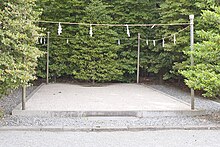User:Ansei/Sandbox-Hashima
| This is a Wikipedia user page. This is not a Wikipedia article or the talk page for a Wikipedia article. If you find this page on any website other than Wikipedia, you are looking at a mirror site. This page may not be up to date, and the user who made this page may have no relationship with any site other than Wikipedia. The original page can be found at https://simple.wikipedia.org/wiki/User:Ansei/Sandbox-Hashima. |
This page has been removed from search engines' indexes.

Hashima change
- "... Here is a fact. Here is where it says this is a fact. Here is where it clarifies that the guy who says this is a fact is not a crank. This is the dog that chased the cat that worried the rat that ate the corn that lay in the house that Fact built ...." -- en:User:Gladys j cortez a/k/a GJC 21:58, 13 February 2010 (diff)
- en:Information cascade
- DJsasso at toolserver.org = credibility?
- What does it mean? To undermine?
A. Undermining as a tactic presents value judgments as facts .[1] It is a self-justifying mechanism.[2]
B. It is axiomatic that to criticise is not per se to undermine.
C. Undermining is qualitatively different. It can seem the same sometimes, but it isn’t. The one is valid, and the other is not.[3]
D. Undermining is a specific kind of impediment or disruption of Wikipedia's collaborative editing.
E. Undermining refers to a process in which an editor and his or her work are strategically undermined. As a tactic, it is an attempt to deflect attention away from the substance of any contribution, focusing instead on the writer.
F. Undermining may
- (a) inhibit an examination of valid issues and
- (b) redirect or re-frame a discussion thread.
G. Often the context will be muddied or worsened by a others, who introduce a simplistic policy-based response instead of addressing the substantive content of a diff or a thread. This can have the effect of sidetracking a discussion into policy interpretations.
H. Within the ambit of undermining tactics are those processes which attempt to achieve "re-branding" within the wiki-community.
I. One form of undermining is hard to spot, harder to anticipate and hardest to deal with because those engaging in it will fiercely deny they are doing so. The problem is marked by an unwillingness to listen to the other side, to acknowledge that someone else has a point, to embrace the notion that this is a complex matter that requires an investment in another way of looking at a controversial topic.[3]
Dispute resolution change
Wikipedia is built upon the principle of collaboration and assuming that the efforts of others are in good faith.
However, for those who use undermining as a tactic, something else becomes the focal point -- not encyclopedia writing.
Graham's Hierarchy of Disagreement
|
|---|
|
File:Graham's_Hierarchy_of_Disagreement1.svg The pyramid graphic which was posted at WP:DR was the only image on the page from 2008-2012. The specific wording of the pyramid graphic emphasizes a few relted terms:
At WP:DR, the image caption is an hortatory command: "Stay in the top three sections of this pyramid." |
Deligitimization change
In the course of history, individuals and groups have been targeted; and this caused the development of the "theory of delegitimization" as an academic framework.[4]
For example, images of derogated target groups were published in the Italian Fascist magazine La Difesa della Razza in the 1930s. These were classified according to eight undermining strategies,[5] including trait characterisation, political labels, group comparison, segregation, outcasting and using a delegitimized group to stigmatize another group.[6]
In 1975, "delegitimization" became a kind of "buzz word" when then-U.S. Ambassador to the United Nations Daniel Patrick Moynihan accused the international body of delegitimizing Israel by passing a "Zionism is racism" resolution.[7]
The paired concepts of "legitimize" and "de-legitimize" have gained currency in discussions about nuclear disarmament.[8]
Notes and references change
- ↑ Clabaugh, Gary et al. (2007). Analyzing Controversy, p. 36.
- ↑ Volpato, Chiara et al. "Picturing the Other: Targets of Delegitimization across Time", International Journal of Conflict and Violence (Germany). Vol. 4, No. 2 (2010), p. 273, citing Daniel Bar-Tal. (1990). "Causes and Consequences of Delegitimization: Models of Conflict and Ethnocentrism," Journal of Social Issues, Vol. 46, pp. 65-89; retrieved 2011-09-18.
- ↑ 3.0 3.1 Blair, Tony. "It is a democratic duty to counter deleligitimisation of Israel," Speech by the Madrid Quartet Representative at Herzliya, Israel, 24 August 2010.
- ↑ Volpato, p. 272; retrieved 2011-09-20.
- ↑ Volpato, (abstract); retrieved 2011-09-18.
- ↑ Volpato, p. 275; retrieved 2011-09-18.
- ↑ Rosenberg, M.J. "Israel: 'Delegitimization' is just a distraction," Los Angeles Times (US), July 17, 2011; Lis, Jonathan. "Livni: Delegitimization of Israel exacerbates other threats," Haaretz (Israel). August 24, 2010; retrieved 2011-09-19.
- ↑ Blair, Bruce et al. "Smaller and Safer, A New Plan for Nuclear Postures," Foreign Affairs (US), Vol. 89, No. 5, September/October 2010; excerpt, "These postures also perpetuate a mutual reliance on nuclear weapons that lends legitimacy to the nuclear ambitions of other nations"; compare Berry, Ken et al. "Delegitimizing Nuclear Weapons: Examining the Validity of Nuclear Deterrence," Monterey Institute of International Studies. May 2010; retrieved 2011-09-20.
Further reading change
- Berry, Ken et al. "Delegitimizing Nuclear Weapons: Examining the Validity of Nuclear Deterrence," Monterey Institute of International Studies. May 2010
- Blair, Tony. "It is a democratic duty to counter deleligitimisation of Israel," Speech by the Madrid Quartet Representative at Herzliya, Israel, 24 August 2010.
- Brimmer, Esther. "Multilateral Cooperation Between The United States and Israel: Fighting Delegitimization, Moving Forward Together," Address at the Washington Institute for Near East Policy, June 15, 2011.
- Clabaugh, Gary K. and Edward G. Rozycki. (1997). Analyzing Controversy (1st edition). Guilford, Connecticut: Dushkin/McGraw-Hill. 10-ISBN 0697343359/13-ISBN 9780697343352; OCLC 37662714
- Volpato, Chiara et al. "Picturing the Other: Targets of Delegitimization across Time" (abstract), International Journal of Conflict and Violence (Germany). Vol. 4, No. 2 (2010), pp. 269-287.